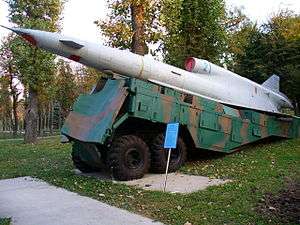Tupolev Tu-141
The Tupolev Tu-141 Strizh (Swift, Russian: Стриж) is a Soviet reconnaissance drone that served with the Soviet Red Army during the late 1970s and 1980s.
| Tu-141 Strizh | |
|---|---|
| Tu-141 Strizh at Central Air Force Museum, Monino, Russia | |
| Role | Remotely-controlled, UAV |
| Manufacturer | Tupolev |
| First flight | 1974 |
| Introduction | 1979 |
| Status | Retired in the USSR/Russia (1989) but reintroduced to service in Ukraine (2014)[1] |
| Primary users | Soviet Union Russia Ukraine |
| Produced | 1979–1989 |
| Number built | 142 |
| Developed from | Tupolev Tu-123 |
| Developed into | Tupolev Tu-143 |
Development

The Tu-141 was a follow-on to the Tupolev Tu-123 and was a relatively large, medium-range reconnaissance drone. It was designed to undertake reconnaissance missions several hundred kilometers behind the front lines at transonic speeds. It could carry a range of payloads, including film cameras, infrared imagers, EO imagers, and imaging radar.
As with previous Tupolev designs, it had a dart-like rear-mounted delta wing, forward-mounted canards, and a KR-17A turbojet engine mounted above the tail. It was launched from a trailer using a solid-propellant booster and landed with the aid of a tail-mounted parachute.
The Tu-141 was in Soviet service from 1979 to 1989, mostly on the western borders of the Soviet Union.
Combat usage
The Tu-141 was pressed back into service by the Ukrainian Air Force for the War in Donbass.[1][2]
Specifications
Data from Unmanned Aerial Vehicles Directory: Part 2[3]
General characteristics
- Crew: none
- Length: 14.33 m (47 ft 0.25 in)
- Wingspan: 3.88 m (12 ft 8.5 in)
- Height: 2.44 m (8 ft 0 in)
- Wing area: 10.0 m2 (108 sq ft) [4]
- Gross weight: 6,215 kg (13,702 lb)
- Powerplant: 1 × Tumansky KR-17A , 19.6 kN (4,409 lbf) thrust
Performance
- Maximum speed: 1,100 km/h (683 mph, 594 kn)
- Cruise speed: 1,000 km/h (620 mph, 540 kn)
- Range: 1,000 km (620 mi, 540 nmi)
- Service ceiling: 6,000 m (19,700 ft)
References
- "Ukraine Resurrects Soviet-Era Super Drones".
- https://theaviationist.com/2014/08/02/tu-143-in-field/
- Munson Air International August 1997, p. 101.
- Gordon and Rigmant 2005, p. 321.
- Gordon, Yefim and Vladimir Rigmant. OKB Tupolev: A History of the Design Bureau and its Aircraft. Hinkley, UK: Midland Publishing, 2005. ISBN 978-1-85780-214-6.
- Munson, Kenneth. "Unmanned Aerial Vehicles Directory: Part 2". Air International, August 1997, Vol 53 No 2. pp. 100–108.
This article contains material that originally came from the web article Unmanned Aerial Vehicles by Greg Goebel, which exists in the Public Domain.
External links
| Wikimedia Commons has media related to Tupolev Tu-141. |